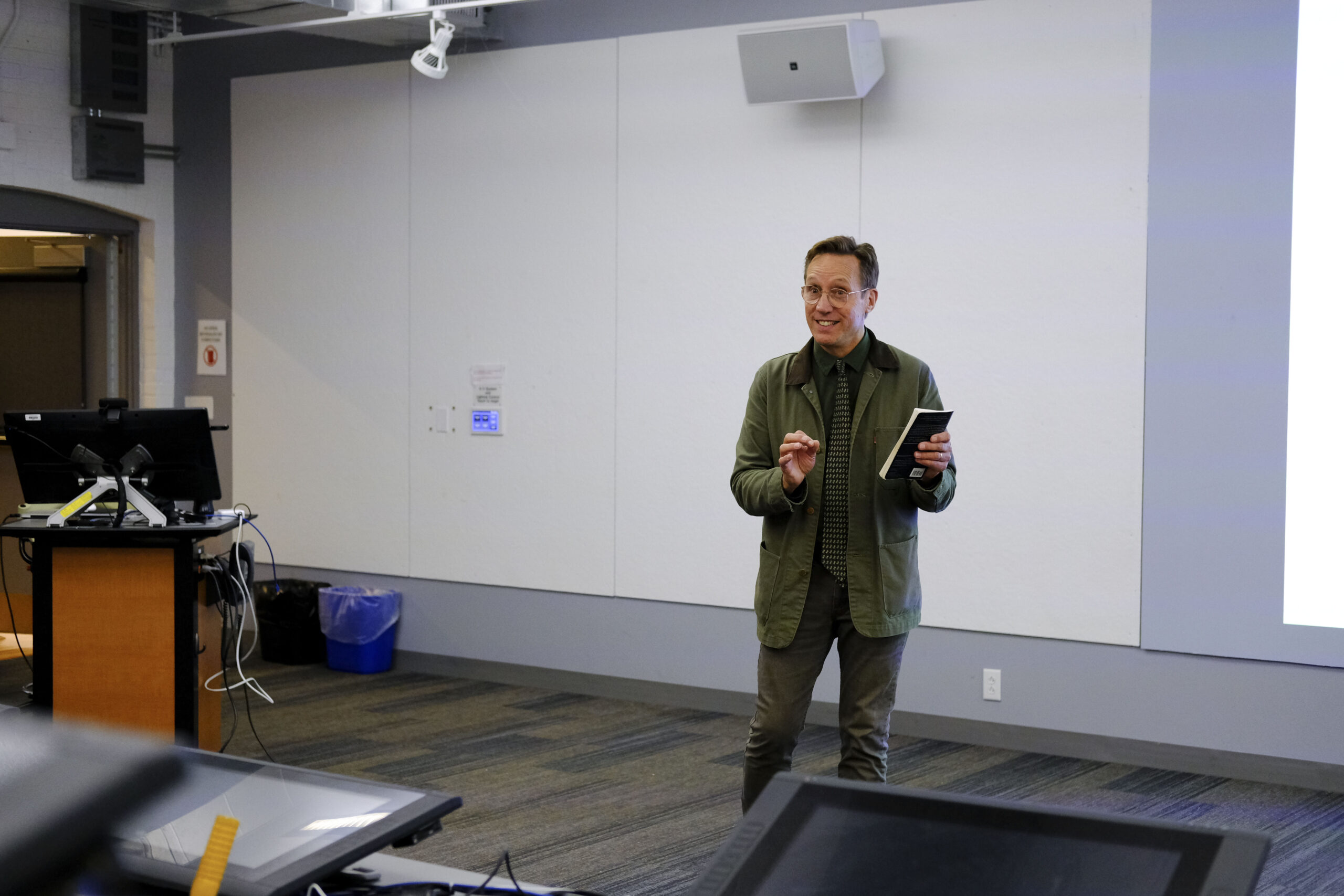Painter’s lecture emphasizes a need for collaboration
October 18, 2019
 Devaki Rajiv
Devaki RajivArtist and educator Bruce Herman has made a great individual mark on the art world with striking paintings and immersive multimedia projects, but at his talk at Bowdoin last Monday his focus was the collaboration that has shaped his career.
Herman, the current Lothlórien Distinguished Chair in Fine Arts at Gordon College as well as an artist, professor, and curator there since 1984, has given lectures and exhibited his work at colleges and universities across the world.
Rather than focusing on the beauty and complexity of his work, Herman embedded his lecture with anecdotes and presentations of the people and media that have shaped his career over the years. He began by pulling out his annotated and weathered copy of T.S. Eliot’s “Four Quartets,” and reading aloud from the book.
“Look in my direction,” said Herman, making eye contact with his audience. “I need to know that I’m connecting.”
Connection and universality were constantly at the forefront of the lecture. Even as Herman displayed his own paintings, he continued to reiterate what he believes to be his purpose as an artist, and his journey to reach this conclusion.
He spoke fondly of his interactions with painter Phillip Guston, an important mentor and critic of his own earlier work in graduate school. Herman recalled one incident in which Guston urged Herman to “kill” one of Herman’s especially large and laborious paintings.
“‘Make it more personal,’” Herman said, recalling Guston’s advice. “Then, it’ll be universal.’”
“He wasn’t condemning what I’d done,” elaborated Herman. “He was just saying, ‘You’re trying to solve all the problems in one day—you can’t do it.’”
Herman looks to his idols, collaborators and critics as the shapers of his work. When he projected his work, he presented them not as independent creations, but as heavily influenced by prose such as Eliot’s and advice such as Guston’s. Herman made it indisputably clear that he attributed much of his success as an artist to his external influences and collaborations.
“My sort of passion as a painter is to connect with people outside of my silo, with composers and poets, novelists, literary people, performers,” said Herman. “I love to collaborate.”
Indeed, Herman devoted a significant portion of his lecture to exhibiting his multimedia collaborative works, such as his 2013 project “Q U 4 R T E T S.” Inspired by Eliot’s writing, Herman worked on this project with visual artist Makoto Fujimura, Yale School of Music composer Christopher Theofanidis and Thomas A. Langford Distinguished Professor of Theology at Duke University Jeremy Begbie.
When asked if he believed that collaboration fortifies an individual’s artistic voice, Herman responded with a resounding “yes.”
“[Collaboration] is like any really, really good conversation. When someone [tries] to dominate a conversation, it dies,” said Herman. “There’s great freedom there, when you don’t try to dominate—when you actually listen to the other person, and you actually submit to their voice.”
Herman does not simply rely on himself and his colleagues to carry the significance of his art; he also pays attention to how his audience, from Maine to Hong Kong, interprets his work. Often, those interpretations reveal what we have in common—basic wants, whether it be for intimacy or peace.
“It’s amazing,” he gushed. “I mean, it’s like discovering over and over again, that people everywhere, in all times, and all cultures, and all languages, and all levels of society, have the same hope that their lives will mean something and that they will connect with others … to find that connection and to celebrate it, and to welcome other people into it, is what I was made for.”
Though Herman is an accomplished artist with the right to devote the majority of his lecture to a discussion of his own work; his lecture focused instead on how and why he makes art. By bringing influential figures and forces into the conversation, Herman provided insight into his own artistic style and vision.
“My art isn’t about me … it’s about valuing and caring about the other,” said Herman with conviction. “[It’s about] knowing that whoever the other is, wherever they come from, whatever their language or their customs, they’re valuable. They’re infinitely valuable.”

Comments
Before submitting a comment, please review our comment policy. Some key points from the policy: